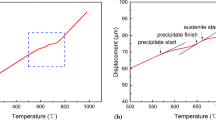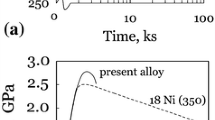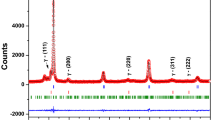Abstract
The effect of nickel and molybdenum concentrations on the phase transformation and mechanical properties of conventional 18Ni(350) maraging steel has been investigated. Both of these elements act as strong austenite stabilizers. When the concentration of molybdenum or nickel is greater than 7.5 or 24 wt %, respectively, the austenite phase remains stable up to room temperature. In both molybdenum- and nickel-alloyed steels, the austenite phase could be transformed to martensite by either dipping the material in liquid nitrogen or subjecting it to cold working. When 7.5 wt% Mo and 24 wt% Ni were added in combination, however, the austenite phase obtained at room temperature did not transform to martensite when liquid-nitrogen quenched or even when cold rolled to greater than 95% reduction. The aging response of these materials has also been investigated using optical, scanning electron, and scanning transmission electron microscopy.
Similar content being viewed by others
References
R.K. Wilson, Ed.,Maraging Steels: Recent Developments and Applications, TMS, 1988
S. Floreen,Metall. Rev., Vol 13, 1968, p 115–128
R.F. Decker, Ed.,Source Book on Maraging Steel, R.E. Decker, Ed., American Society for Metals, 1979
R.F. Decker, J.T. Eash, and A.J. Goldman, 18% Ni Maraging Steels,Source Book on Maraging Steel, R.F. Decker, Ed., American Society for Metals, 1979,p 1–19
A. Magnee, J.M. Dropier, J. Dumont, D. Cousourdis, and L. Habraken,“Co-Containing High Strength Steel: A Critical Review of the Physical Metallurgy of Co-Containing High Strength Steel and a Survey of Their Processing, Properties and Uses,” Center D’Information du Cobalt, Brussels, 1974, p 50–123
W. Sha, A. Cerezo, and G.D.W. Smith, Phase Chemistry and Precipitation Reactions in Maraging Steel,Metall. Trans. A, Vol 24A (No. 6), David e. Laughlin, Ed., 1993
M. Ahmed, S.K. Hasnain, F.H. Hashmi, and A.Q. Khan, The Magnetic Properties of Maraging Steel in Relation to Structural Phase Transformations,Proc. MRS Int. Meeting on Advanced Materials, Vol 11, Materials Research Society, 1988, in press
M. Ahmed, A. Ali, S.K. Hasnain, F.H. Hashmi, and A.Q. Khan, Magnetic Properties of Maraging Steel in Relation to Deformation and Structural Phase Transformations,Ada Metall. Mater., Vol 42 (No. 3) 1994, p 631–638
M. Ahmed, 1. Nasim, 1. Salam, S.W. Husain, F.H. Hashmi, and A.Q. Khan, Reclamation and Additional Alloying of Maraging Steel,J. Mater. Eng. Perform., Vol 3 (No. 6), 1994, p
R.F. Decker and S. Floreen, Maraging Steels—The First 30 Years,Maraging Steels: Recent Developments and Applications, R.K. Wilson, Ed., TMS, 1988
S. Machlin and M. Cohen,Trans. AIME, Vol 194, 1952, p 489
M. Ahmed, M. Farooq, F.H. Hashmi, S.W. Husain, and A.Q. Khan, An In-Situ Study of Phase Transformations in Maraging Steels,Maraging Steels: Recent Developments and Applications, R.K. Wilson, Ed., TMS, 1988
Author information
Authors and Affiliations
Rights and permissions
About this article
Cite this article
Ahmed, M., Nasim, I. & Husain, S.W. Influence of nickel and molybdenum on the phase stability and mechanical properties of maraging steels. JMEP 3, 248–254 (1994). https://doi.org/10.1007/BF02645850
Issue Date:
DOI: https://doi.org/10.1007/BF02645850




